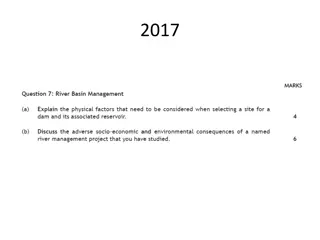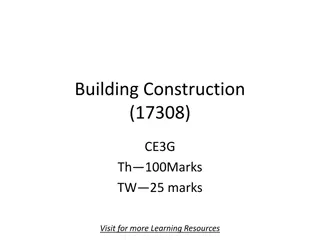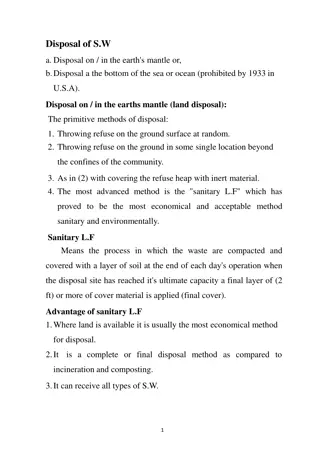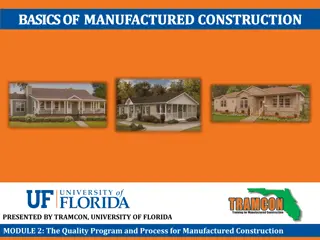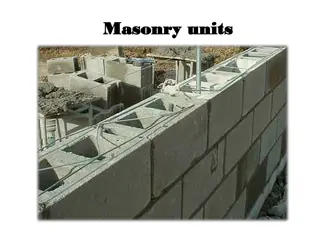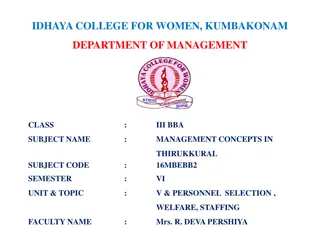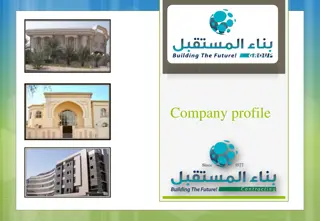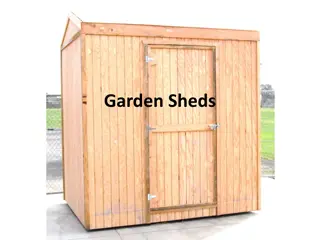Essential Factors to Consider in Site Selection for House Construction
Each family aims to meet its housing needs through selecting a dwelling unit. Choosing the right site for building a house is crucial due to its long-term implications. Factors like physical features, soil conditions, sanitary facilities, practical convenience, and a good neighborhood should all be carefully considered to ensure a suitable and comfortable living environment.
Download Presentation

Please find below an Image/Link to download the presentation.
The content on the website is provided AS IS for your information and personal use only. It may not be sold, licensed, or shared on other websites without obtaining consent from the author. Download presentation by click this link. If you encounter any issues during the download, it is possible that the publisher has removed the file from their server.
E N D
Presentation Transcript
TOPIC HOME MANAGEMENT- 2 BA PART II HONS., 2ndPAPER Dr. AMARJEET KUMAR ASST. PROFESSOR DEPARTMENT OF HOME SCIENCE ROHTAS MAHILA COLLEGE,SASARAM
Site Selection Each family attempts to meet its housing needs through the selection of a dwelling unit. The house is probably the largest single investment you will make in your life. One cannot change one s residence often. Hence it becomes essential for each one of us to have adequate knowledge about selection of a site and house planning. A site in a good locality should be selected. Now let us see the factors to be considered while selecting a site for the construction of a house.
I. Physical Features 1. The site should be regular in shape and should have exact boundaries marked on the land. 2. A low lying ground is unhealthy because it is likely to cause dampness during rainy season and it becomes a breeding place for flies and mosquitoes. 3. The site should be on an elevated ground for drainage of water especially during rainy season. 4. A site on an elevated ground affords wider and brighter view of the house. 5. Site which faces South/North direction is preferable.
II. Soil Conditions 1. The best soil is one where soft soil is at the surface and hard soil beneath 3 or 4 ft. 2. A mixture of sand and gravel is good. 3. Rocky surfaces afford good foundation, but poses difficulty while leveling or excavating the ground due to its hardness. On rocky surface, laying drainage pipe is very costly. Besides, it is not suitable for growing plants. 4. Clay and sandy soils are unsuitable because clay surface holds water for a long time and sandy soil absorbs water
III. Sanitary Facilities 1. There should be no stagnant pools or water tanks and unused wells around the site. 2. The site should never be surrounded by public drainage and toilet. 3. The site should not be selected near cattle sheds, poultry farm and factories for health reasons. 4. Reclaimed land filled with debris and refuse is unhealthy for building purposes, as it will give out obnoxious gases. During rainy season it becomes a good breeding place for flies and mosquitoes. 5. The site should be such as to command fresh air, ample lighting and good water supply. 6. A site in a busy locality may not be suitable for health reasons because of dust and the constant smoke from vehicles. 7. A site with modern sanitary facilities is the most suitable.
IV. Practical Convenience The value of the site depends upon the convenience available around. The site should be within easy reach to school, market, bank, hospital or nursing home, railway station, bus terminus and post office. v. Good Neighbourhood 1. The site should be selected near a developed area for safety. 2. Good neighbourhood adds to the permanent happiness of the family. 3. The economic and social status of the neighbourhood should be on par with the occupants. 4. The area should be pleasant and charming. 5. The site in the neighbourhood of a sea commands pleasant sea breeze. But one disadvantage is that sea breeze carries with it a thin spray of salty water, which corrodes all iron articles.
VI. Legal Characteristics 1. The legal description of the plot and the exact location of the plot must be known. 2. The site should be a freehold land without encumbrance. 3. A legal advisor should be consulted, the place surveyed and the boundaries marked on.
Activities in the house and space allocation The house and its grounds can be divided into three major areas based on the various activities of the house. 1) Social or public area - The rooms allotted are, verandah, living room, reception, dining, music, reception and games room. 2) Service or Work area - The rooms allotted are kitchen, serving, laundry, drying yard, ironing room, garage, storage areas, office and study room. 3) Rest or private area - Bedroom, dressing room, bathrooms, prayer room etc. It is not possible to allot room for each and every activity separately, but it is important to allot spaces for the more important ones.
Rooms in the house A verandah serves many purposes. It is a place for stranger or a visitor to wait. It is a place for keeping shoes, walking sticks, umbrellas and a place to store vehicles. It provides place for business, the postman, the newspaper boy, milkman, and the vendors to call on the family members at the entrance. It serves as a passage to other rooms of the house. It is a place for sitting in the evening or at night after dinner enjoying light reading, or conversation with family members and neighbours. In small houses, it is the main sitting room. It protects the walls of the house from the direct rays of the sun. It is a place for pets and also a place for growing plants. The Back Verandah It serves different functions such as grinding, drying clothes etc. A verandah more than 3.6 m wide is not economical. A verandah facing south or west is comfortable.
Living Room Living room is placed adjacent to verandah. The living room should provide place for many of the family activities as reading, conversation, get together, indoor games and light music. It is a place to receive friends and also to hold social functions. In a small house, it can serve as a study room for children, sleeping area for one or two members. It can be a dining room during special occasions. At times it can accommodate guests. Thus, it may serve multi various functions, depending upon the type of the family. A living room should express cordial welcome to the friends of the family. The living room should be well lighted and well ventilated and should provide maximum comfort for the family members. The living room should be situated on one side with an entrance from front verandah. The minimum size for a living room should be 4.5m by 3.6m(15 ft. by 12 ft). The size of the door should be 90cms as minimum width and should be at one side of the wall. A coating of oil painting on tiles fixed on walls for a distance of 1.5 m from the floor is good from the sanitary point of view. The furniture and furnishing that are used in the living room must be comfortable and suitable for the room. For example,
For conversation- sofa, chairs, For hospitality- a center coffee table For reading- table, chairs and bookcase For recreation- radio and television cabinet, table and chairs The living room should be simple in design. There should be enough wall space for hanging pictures and for display of decorative articles. Flower arrangements add beauty to the room. A shelf may be provided for art objects.
Bed Room One spends more than 1/3 of his/her lifetime at rest and instead of in sleep here. It can provide place for dressing and storage of clothes. Practically 4.5m by 3.5m has been found to be a good size for a bedroom. A rectangular room is more convenient than a square one. No room should have less than 3sq.m. of the floor area. Ventilation is of utmost importance in bedroom. It should be on the side of the direction of prevailing wind. The door of the bedroom should be located in such a way that when opened the bed is not visible fully. Bathroom attached to a bedroom would add to the convenience of the family members. Some storage space should be provided in the bedroom. Built-in cupboards for clothes and bed linen save space. A chest of drawers could also be provided. A small table and a chair may find a place to keep some of the books for light reading, table lamp, flower arrangements etc. It is better that parents have a separate master bedroom and children above ten years have separate bedrooms.
Kitchen: Kitchen is aptly described as the home maker s workshop. It is the nerve Centre of the house, a place where we cook food, store our food, utensils and provisions. It can provide space for eating too. The comfort, health and happiness of the family mainly depends on the activities carried out in the kitchen. Homemakers in India spend 70% of their time in the kitchen. Kitchen should never be a suffocating chamber of pungent smoke irritating the eyes, nose, lungs and also the temper of the housewife. The apartments pose some of the problems such as lack of space and uncomfortable arrangements. It is very essential that one gives enough thought to the kitchen arrangements. Location: The best location will be eastern or north-eastern corner of the house. This is helpful in having purified air and also warmth in the morning and coolness during the other part of the day. Size and shape For actual efficiency the kitchen should be neither too small nor too large. A rectangular kitchen is step saving. The size can vary from 3m by 2.4m or 3m by 3m. Activities and work centers The main activities in the kitchen are food preparation, cooking and cleaning of food items and equipment. The work area for these three activities should be carefully planned. The kitchen should have the preparation, cooking and washing centers adjoining each other at comfortable heights to form a triangle. This work triangle ensures convenience and safety
The various shapes in which the major work centers can be arranged are U shaped, L shaped, one wall and parallel walls. The ideal shape for the kitchen arrangement is U . preparation and cooking centers on either side and the cleaning center in the middle. This is a compact arrangement and labor saving too. In the L -shaped kitchen arrangement of the work centers are placed on two adjoining walls. The one wall arrangement is suitable for small kitchen. It consists of Fig. 2. Types of kitchen.
Cooking Centre The range with the storage of utensils needed for cooking occupied an important place in the kitchen. A peg board for frying pans and auce pans, a holder for knives and spoons and all the food items and equipment must be placed within easy reach in the cooking center. Washing Centre Storage cupboard for dishcloth and brushes can be hung in convenient place provided there. Sink should always be placed in front of a window. Garbage pail should be kept near or under the sink. Preparation Centre Placement of a refrigerator in the preparation center facilitates easy handling of vegetable, milk, egg and fruits during preparation. The equipment like blenders, beaters, sifters, saucepans, measuring cups, spoons, knives, spatula should be stored here. Height of the working center It can be 80 to 90cms depending upon the height of the person working in the kitchen. Storage facilities in the kitchen Built-in cupboard or cupboard with drawers and rack can be provided. Care should be taken to avoid insects. The wall area above and below the counter should be made full use of.
Bathroom The purpose of a bathroom is to provide facilities for bathing, washing and dressing too. The main bathroom should be in the ground floor not far away from the main rooms. It can be attached to the bedroom for convenience. A bathroom with 1.5m by 1.8m in size is necessary. If area for keeping water boiler and washing clothes are to be provided the size may be 1.8m by 3m. There should be good ventilation in the bathroom. A window at the usual level with frosted glass shutters, admitting light but keeping privacy, is good. A ventilator at the height of 180 cm. above the ground level is helpful. Loft can be provided to store things if necessary. Small built-in shelf may be used for keeping oil, soap, brush, paste, etc. The flooring finish should be easy to clean. It should never be slippery. The wall should have a polished surface to a height of 90cms from the floor. There should be good drainage facilities for removal of waste water from the bathroom. Water closet or latrine Water closet can be near the house or even inside the house. Now a days they can be flushed with the water. The latrine on basket system is not sanitary. Earth closets can be used in rural areas. The minimum space needed is 1.2m by 1.8m in width and length. Strictest privacy is required in these rooms in respect of light and sound. The lavatory should be kept clean. The basin should be cleaned daily with a reagent. The room should be washed with disinfectant like phenol/Dettol. If bath section and water closet are combined, more space is needed. The room may be equipped with mirror, washbasin, closed storage for toilet articles, a rack to keep clothes and towels, tub, mug, etc. There should be tap connection for running water. Facilities for shower bath add to the convenience and pleasure.









